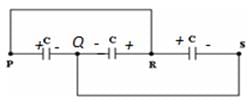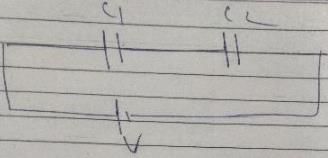All questions of Electrostatic Potential and Capacitance for JEE Exam
The amount of work done in moving a charge from one point to another along an equipotential line or surface charge is- a)Zero
- b)Infinity
- c)One
- d)Two
Correct answer is option 'A'. Can you explain this answer?
|
|
Om Desai answered |
Two equipotential surfaces have a potential of -10V and 90V respectively, what is the difference in potential between these surfaces?- a)90V
- b)80V
- c)0V
- d)100V
Correct answer is 'D'. Can you explain this answer?
|
|
Krishna Iyer answered |
so our high potential is 90V and low potential is 10V,
potential = 90-(-10)=100V
Which of the following is a non polar dielectric?- a)Water
- b)Alcohol
- c)HCl
- d)Benzene
Correct answer is option 'D'. Can you explain this answer?
|
|
Riya Banerjee answered |
What will be the effect on capacitance, if the distance between the parallel plates reduced to one-third of its original value?- a)decrease by a factor 3
- b)increase by a factor 3
- c)increase by a factor 3/2
- d)increase by a factor ½
Correct answer is option 'B'. Can you explain this answer?
|
|
Preeti Khanna answered |
Hence,C1/C2=d2/d1=(d/3)d=3
C2=3C1
1 microfarad is equal to- a)10-6F
- b)10-12F
- c)10-15F
- d)10-9F
Correct answer is option 'A'. Can you explain this answer?
|
|
Lavanya Menon answered |
Work done in carrying 2C charge in a circular path of radius 2m around a charge of 10C is- a)6.67J
- b)60J
- c)Zero
- d)15J
Correct answer is option 'C'. Can you explain this answer?
|
|
Suresh Iyer answered |
It is a well-known fact that W=qdv.
Here dV is the change in overall potential. In the circular orbit of r potential at each point is similar.
Most significantly, the value of r is 3.
The value of dv=0 and hence W=q0=0.
Electric field intensity at point ‘B’ due to a point charge ‘Q’ kept at a point ‘A’ is 12 NC-1 and the electric potential at a point ‘B’ due to same charge is 6 JC-1. The distance between AB is- a)2 m
- b)1.5 m
- c)1 m
- d)0.5 m
Correct answer is option 'D'. Can you explain this answer?
|
|
Nandini Patel answered |
The polarized dielectric is equivalent to- a)non-zero volume charge density
- b)one charged surface with induced surface charge density
- c)two charged surfaces with induced surface charge densities
- d)zero surface charge density
Correct answer is option 'C'. Can you explain this answer?

|
Learners Habitat answered |
As shown in the figure below, an ellipsoidal cavity is carved within a perfect conductor. A positive charge Q is placed at the centre of the cavity. If points A and b are shown on the cavity surface (see figure), then which among the following choices is correct?
- a)Potential at A = Potential at B
- b)Charge density at A = Charge density at B
- c)Electric field near A = Electric field near B
- d)Total electric flux at the surface of the cavity = zero
Correct answer is option 'A'. Can you explain this answer?
|
|
Om Desai answered |
we know that conductor is an equipotential surface, so potential will be the same at A and B.
As charge density, σ∝1/r, then charge density is different at A and B.
Five capacitors are connected as shown in the figure. Initially S is opened and all capacitors are uncharged. When S is closed, steady state is obtained. Then find out potential difference between the points M and N. 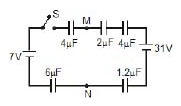
- a)14
- b)12
- c)10
- d)15
Correct answer is option 'B'. Can you explain this answer?
|
|
Krishna Iyer answered |
Here, Equivalent capacitance = ½,
EMF = 24
Thus, charge passes through each capacitor = 12 μC
Voltage across 4μF = 3V
Voltage across 6μF = 2V
=> Potential difference (V):
V = 3 + 7+ 2 = 12V
Thus, potential difference (V) between the two given points M and N is 12v.
The electrostatic potential energy between two charges q1 and q2 separated by a distance by r is given by- a)

- b)

- c)

- d)

Correct answer is option 'D'. Can you explain this answer?

|
Khushi Mittal answered |
If 100 J of work has to be done in moving an electric charge of 4C from a place where potential is -5 V to another place, where potential is V volt. The value of V is- a)15 V
- b)20 V
- c)25 V
- d)10 V
Correct answer is option 'B'. Can you explain this answer?
|
|
Suresh Iyer answered |
W=q0x[vfinal-vinitial ]
100=4x[v-(-5)]
v+5=25
v=20V
Can you explain the answer of this question below:Equal charges are given to two spheres of different radii. The potential will
- A:
be equal on both the spheres
- B:
be more on the smaller sphere
- C:
be more on the bigger sphere
- D:
depend on the material of the sphere
The answer is b.
Equal charges are given to two spheres of different radii. The potential will
be equal on both the spheres
be more on the smaller sphere
be more on the bigger sphere
depend on the material of the sphere

|
Husna answered |
A hollow metal sphere of radius 5cm is charged so that the potential on its surface is 10V. The potential at a distance of 2cm from the centre of the sphere is- a)4V
- b)zero
- c)10/3V
- d)10V
Correct answer is option 'D'. Can you explain this answer?

|
Ayush Joshi answered |
Two capacitors of 20 μƒ and 30 μƒ are connected in series to a battery of 40V. Calculate charge on each capacitor.- a)480 C
- b)478 C
- c)450 C
- d)500 C
Correct answer is option 'A'. Can you explain this answer?
|
|
Nikita Singh answered |
Here is a combination of three identical capacitors. If resultant capacitance is 1 μƒ, calculate capacitance of each capacitor.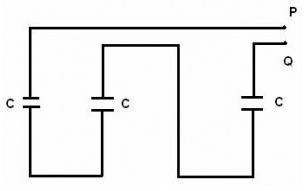
- a)6 μƒ
- b)3 μƒ
- c)4 μƒ
- d)2 μƒ
Correct answer is option 'B'. Can you explain this answer?
|
|
Lavanya Menon answered |
C(effective) = C/3 = 1
When two capacitors C1 and C2 are connected in series and parallel, their equivalent capacitances comes out to be 3 μƒ and 16 μƒ respectively. Calculate values of C1 and C2.- a)4μƒ and 12μƒ
- b)6μƒ and 10μƒ
- c)4μƒ and 10μƒ
- d)6μƒ and 12μƒ
Correct answer is option 'A'. Can you explain this answer?

|
Anonymous answered |
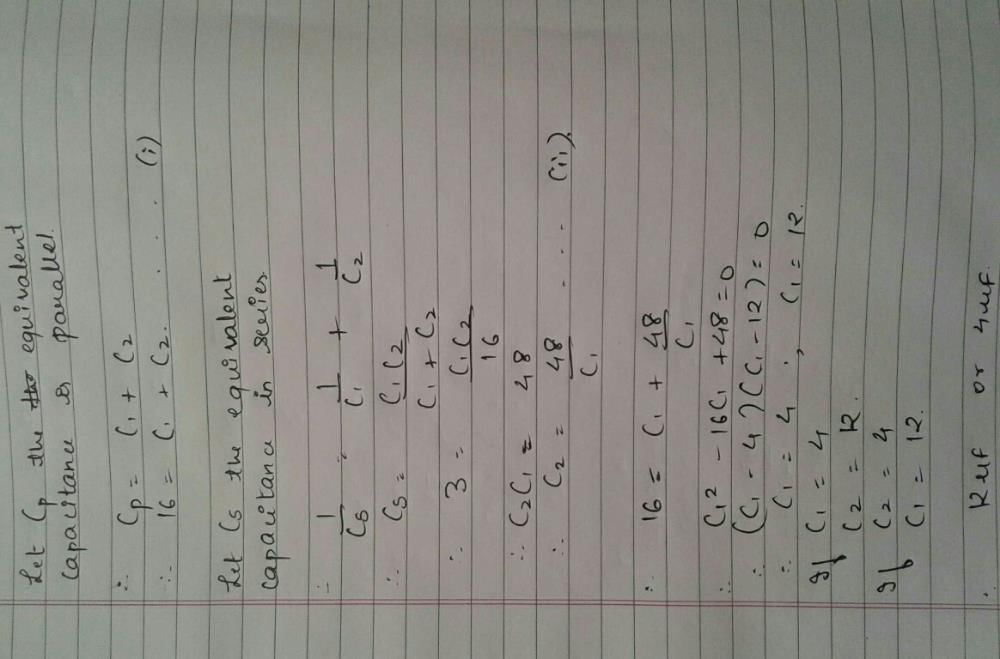
Three uncharged capacitors of capacitane C1 = 1mF, C2 = 2mF and C3 = 3mF are connected as shown in figure to one another and to points A, B and D potential fA = 10V, fB = 25V and fD = 20 V, Determine the potential (f0) at point O.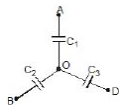
- a)20 V
- b)30 V
- c)40 V
- d)10 V
Correct answer is option 'A'. Can you explain this answer?
|
|
Lavanya Menon answered |
⇒C1(Vo−VA)+C2(Vo−VB)+C3(Vo−VD)=0
⇒(C1+C2+C3)Vo=C1VA+C2VB+C3VD
Vo= C1VA+C2VB+C3VD/ C1+C2+C3
= [(1×10)+(2×25)+(3×20)]/(1+2+3)
=(10+50+60)/6
=20Volts
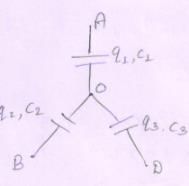
A conductor of capacitance 0.5mF has been charged to 100volts. It is now connected to uncharged conductor of capacitance 0.2mF. The loss in potential energy is nearly- a)7 × 10_4 J
- b)3.5 × 10_4 J
- c)14 × 10_4 J
- d)7 × 10_3 J
Correct answer is option 'A'. Can you explain this answer?
|
|
Jyoti Sengupta answered |
C1=0.5 mf
C2=0.2mf
V=100v
So,
U=(1/2) CTV2
CT=C1C2/XC1+C2=(0.5x0.2/0.5+0.2)mf
CT=0.14mf
U=(1/2)(0.14mf)(100V)2
=(10.07x1-6x104)J
=(7x10-2x10-6x104)J
=7x10-4J
A parallel plate capacitor of area A, plate separation d and capacitance C is filled with three different dielectric materials having dielectric constants k1, k2 and k3 as shown. If a single dielectric material is to be used to have the same capacitance C in this capacitor, then its dielectric constant k is given by
- a)

- b)

- c)

- d)K = K1 + K2 + 2K3
Correct answer is option 'B'. Can you explain this answer?





|
Bs Academy answered |
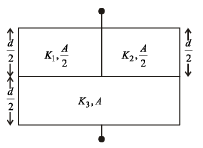
C2 = Capacity of capacitor with K2
C3 = Capacity of capacitor with K3
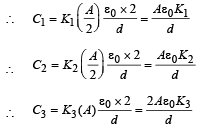


 for single equivalent capacitor
for single equivalent capacitor
Can you explain the answer of this question below:It requires 4 J of work to move a charge of 20 C from point A to point B, separated by a distance of 0.2 cm. The potential difference between A and B in volts
- A:
0.2
- B:
16
- C:
5
- D:
80
The answer is a.
It requires 4 J of work to move a charge of 20 C from point A to point B, separated by a distance of 0.2 cm. The potential difference between A and B in volts
0.2
16
5
80

|
Mayank Singh answered |
A hollow metal sphere of radius 10 cm is charged such that the potential on its surface is 80 volt. The potential at the centre of the sphere is- a)8 volt
- b)zero
- c)800 volt
- d)80 volt
Correct answer is option 'D'. Can you explain this answer?

|
Sunidhi Pandey answered |
Can you explain the answer of this question below:In a parallel plate capacitor the potential difference of 150 V is maintained between the plates. If distance between the plates is 6 mm, what will be the electric field at points A and B?
- A:
2.5×103
- B:
2.5×104
- C:
2.5×105
- D:
3.5×104
The answer is b.
In a parallel plate capacitor the potential difference of 150 V is maintained between the plates. If distance between the plates is 6 mm, what will be the electric field at points A and B?
2.5×103
2.5×104
2.5×105
3.5×104
|
|
Om Desai answered |
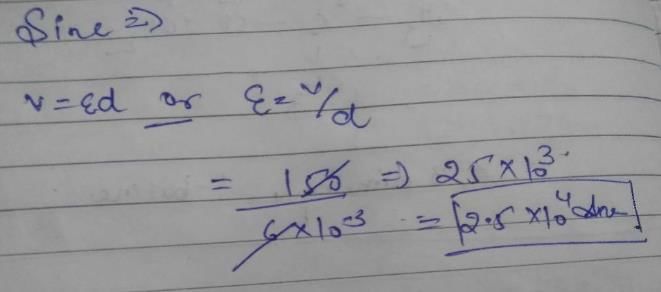
μμf is also called?- a)nanofarad
- b)microfarad
- c)picofarad
- d)fermifarad
Correct answer is option 'C'. Can you explain this answer?
|
|
Arghya answered |
When a positive charge is moved in an electrostatic field from a point at high potential to a low potential, its kinetic energy- a)Remains constant
- b)Decreases
- c)Increases
- d)Either increase or remain constant
Correct answer is option 'C'. Can you explain this answer?

|
Siddhi Bhardwaj answered |
The shape of equipotential surface for an infinite line charge is:- a)Coaxial cylindrical surfaces
- b)Parallel plane surfaces
- c)Parallel plane surfaces perpendicular to lines of force
- d)None of above
Correct answer is option 'A'. Can you explain this answer?
|
|
Rajesh Gupta answered |
The distance between the plates of a capacitor is d. What will be the new capacitance if a metal plate of thickness d/2 is introduced between the plates without touching them- a)it will be thrice of its initial value
- b)it will be double of its initial value
- c)remains the same
- d)it will be half of its initial value
Correct answer is option 'B'. Can you explain this answer?
|
|
Nisha Patel answered |
Capacitance of a capacitor:
The capacitance of a capacitor is given by the equation:
C = εA/d
where C is the capacitance, ε is the permittivity of the medium between the plates, A is the area of the plates, and d is the distance between the plates.
Effect of introducing a metal plate:
When a metal plate of thickness d/2 is introduced between the plates without touching them, the distance between the plates decreases by d/2. This means that the new distance between the plates is d/2.
New capacitance:
Using the equation for capacitance, we can calculate the new capacitance as:
C' = εA/(d/2)
C' = 2εA/d
The new capacitance is double the initial capacitance. Therefore, the correct answer is option B, "it will be double of its initial value."
Two capacitors of 2mF and 3mF are charged to 150 volt and 120 volt respectively. The plates of capacitor are connected as shown in the figure. A discharged capacitor of capacity 1.5 mF falls to the free ends of the wire. Then 
- a) Charge on the 1.5 mF capacitor is 180 mC
- b)Charge on the 2 mF capacitor is 120 mC
- c)Charge flows through A from right to left
- d)Charge flows through A from left to right
Correct answer is option 'A,B,C'. Can you explain this answer?
|
|
Neha Sharma answered |
Charge in 3μF Capacitor =360μC
when 1.5μF falls on the circuit ends, Redistribution of charge now will be:
Charge in 2μF Capacitor =300−xμC
Charge in 3μF Capacitor =360−xμC
Charge in 1.5μF Capacitor =xμC
By Kirchhoff Voltage Law:
x/1.5=[(300−x)/2]+[(360−x)/3]
which gives x=180μC
Therefore, Answers are A, B & C
Two capacitors of equal capacitance (C1 = C2) are shown in the figure. Initially, while the switch S is open, one of the capacitors is uncharged and the other carries charge Q0. The energy stored in the charged capacitor is U0. Sometimes after the switch is colsed, the capacitors C1 and C2 carry charges Q1 and Q2, respectively, the voltages across the capacitors are V1 and V2, and the energies stored in the capacitors are U1 and U2. Which of the following statements is INCORRECT ?
- a)

- b)Q1 = Q2
- c)V1 = V2
- d)U0 = U1 + U2
Correct answer is option 'D'. Can you explain this answer?
|
|
Suresh Iyer answered |
Hence, both get the same voltage. ∴V1=V2 is correct.
We know that Q1=C1V1 and Q2=C2V2
∵C1=C2, Q1=Q2
We know that energy U1=(1/2)C1V12 and U2=(1/2)C2V22
By closing the switch, the C1 or V1 doesn't get affected.
Hence U0=U1 and not U1+U2
Similarly, by closing the switch, the Q1 or V1 doesn't get affected.
Hence Q0=Q1
∵Q0=Q1=Q2, Q0=(1/2)(Q1+Q2)
A parallel plate capacitor of capacitance C is connected to a battery and is charged to a potential difference V. Another capacitor of capacitance 2C is similarly charged to a potential difference 2V. The charging battery is now disconnected and the capacitors are connect in parallel to each other in such a way that the positive terminal of one is connected to the negative terminal of the other. The final energy of the configuration is- a)zero
- b)
 CV2
CV2 - c)
 CV2
CV2 - d)
 CV2
CV2
Correct answer is option 'B'. Can you explain this answer?
|
|
Nikita Singh answered |
As both capacitors are in parallel so equivalent capacitance Ceq=C+2C=3C .
Net potential, Vn=2V−V=V
Energy stored, U=(1/2)CeqVn2=(1/2)×3CV2=(3/2)CV2
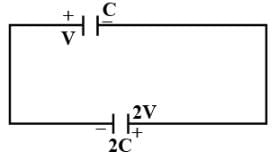
Electric potential is- a)scalar and dimensionless
- b)vector and dimensionless
- c)scalar with dimension
- d)vector with dimension
Correct answer is option 'C'. Can you explain this answer?
|
|
Pooja Mehta answered |
Consider a solid cube made up of insulating material having a uniform volume charge density. Assuming the electrostatic potential to be zero at infinity, the ratio of the potential at a corner of the cube to that at the centre will be - a)1:1
- b)1:2
- c)1:4
- d)1:8
Correct answer is option 'B'. Can you explain this answer?
|
|
Sanaya Kumar answered |

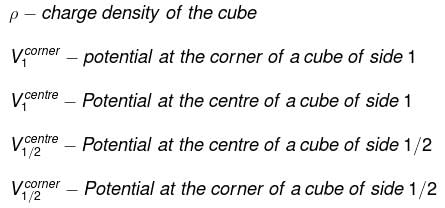


Because of the centre of the larger cube lies at a corner of the eight smaller cubes of which it is made
therefore,

Find the equivalent capacitance of the combination.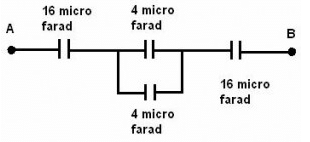
- a)16/3 μƒ
- b)16 μƒ
- c)19.0 μƒ
- d)8 μƒ
Correct answer is option 'C'. Can you explain this answer?

|
Kumari Sakshi answered |
The dipole moment per unit volume is called- a)Polarization
- b)Surface charge density
- c)Linear charge density
- d)Volume charge density
Correct answer is option 'A'. Can you explain this answer?
|
|
Preeti Iyer answered |
Can you explain the answer of this question below:The potential energy of a system containing only one point charge is
- A:
Zero
- B:
Infinity
- C:
Nonzero finite
- D:
None of the above
The answer is a.
The potential energy of a system containing only one point charge is
Zero
Infinity
Nonzero finite
None of the above

|
.mie. answered |
Plate A of a parallel air filled capacitor is connected to a spring having force constant k and plate B is fixed. If a charge +q is placed on plate A and charge _q on plate B then find out extension in spring in equilibrim. Assume area of plate is `A'
- a)

- b)

- c)

- d)none of these
Correct answer is option 'C'. Can you explain this answer?
|
|
Hansa Sharma answered |

At equilibrium,
Felectric=Fspring
qE=kx ____(1)
we know that,
C=Q/V
And V=ε.d
C=Aε0/d
Therefore, ε=θ/Aε0
Here, ε=q/ Aε0
Putting the value in the equation (1)
q/ Aε0=kx
x=q2/akε0
The capacitance of a metallic sphere will be 1mF, if its radius is nearly- a)9 km
- b)10 m
- c)1.11 m
- d)1.11 cm
Correct answer is option 'D'. Can you explain this answer?
|
|
Geetika Shah answered |
Therefore,
Electric field at the surface of a charged conductor is proportional to- a)Surface charge density
- b)Volume of the sphere
- c)Volume charge density
- d)Area of the sphere
Correct answer is option 'A'. Can you explain this answer?

|
Ciel Knowledge answered |
We clearly see that the electric field is perpendicular to surface charge density (σ).
In bringing an electron towards another electron, the electrostatic potential energy of the system- a)becomes zero
- b)decreases
- c)remains same
- d)increases
Correct answer is option 'D'. Can you explain this answer?
|
|
Nandini Patel answered |
Chapter doubts & questions for Electrostatic Potential and Capacitance - Chapter-wise Tests for JEE Main & Advanced 2025 is part of JEE exam preparation. The chapters have been prepared according to the JEE exam syllabus. The Chapter doubts & questions, notes, tests & MCQs are made for JEE 2025 Exam. Find important definitions, questions, notes, meanings, examples, exercises, MCQs and online tests here.
Chapter-wise Tests for JEE Main & Advanced
446 docs|929 tests
|

